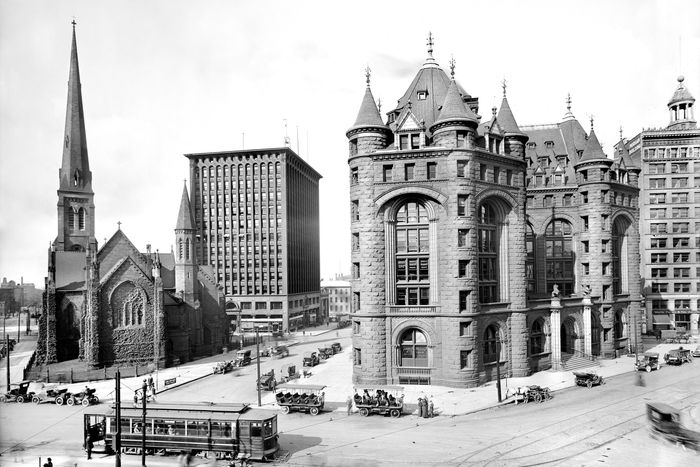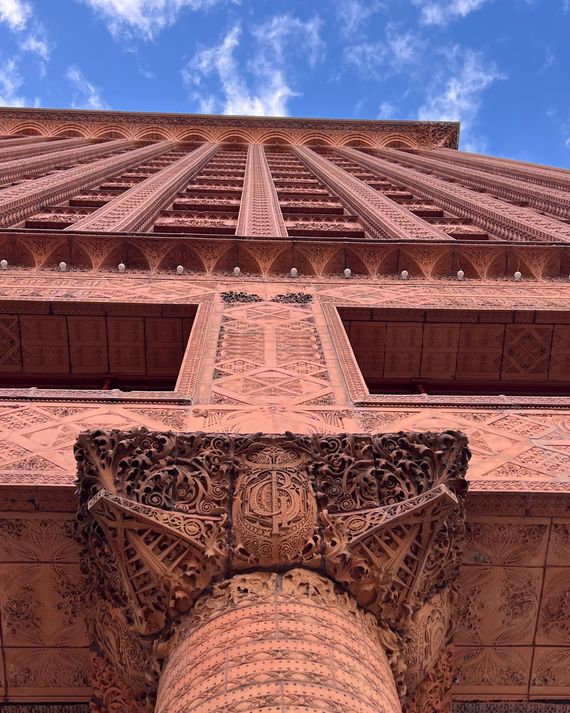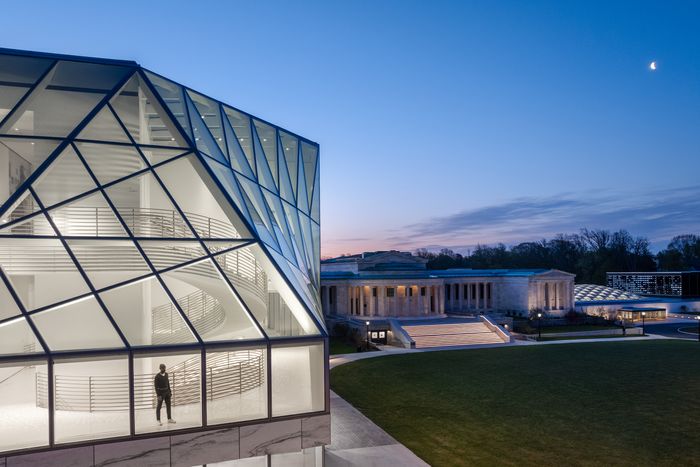Buffalo Is Doing Preservation (Mostly) Right

Buffalo’s Larkin Square went from soap manufacturing to limbo to craft cocktails.
Photo: Sharon Cantillion
There are few urban places more desolate than downtown Buffalo on a Sunday afternoon, especially a Sunday afternoon when the city’s entire population is watching the Bills play a home game. I executed one of those frictionless parking maneuvers I thought took place only in movies, sidling up to a vacant stretch of curb, and in the two hours my wife and I spent trudging down bleak blocks and across vast intersections, we saw only a handful of other pedestrians, most engaged in hostile conversation with themselves. Like many Rust Belt cities, Buffalo has tried to resuscitate its core by alternating spasms of demolition and new construction. Authorities took down abandoned houses and shuttered shops, paved parking lots as placeholders for chimerical new corporate headquarters, erected modernist towers that only dramatized the deadness, and inserted arenas and casinos that kill off more street life than they create. But Buffalo, unlike many other formerly rich factory towns, has also quietly, patiently, and effectively resisted the forces of erasure and learned to value what it already has — essentially, to fix up properties instead of tearing them down. That approach can be cumbersome, time-consuming, and expensive, as wrecking-ball-happy developers are always quick to point out. But Buffalo has been at it long enough to make a persuasive argument: Preservation pays.
At the center of the eerie cityscape, we found one of the visually busiest and most eloquent works of American commercial architecture: Louis Sullivan’s 1896 Guaranty Building. This early steel-frame skyscraper, encrusted with terra-cotta reliefs of flowers, seed pods, vines, leaves, nautilus shells, fishbones, and fractal geometries, speaks of an era of urban hubbub, when office workers dodged streetcars and sidewalk conversations ricocheted off the ornate surface. The building has suffered its share of outrages: After being ruthlessly remodeled in the 1970s, it was left to rot, given up for dead, then rescued and restored in the ’80s. The law firm Hodgson Russ eventually took it over and commissioned a further round of restoration from Gensler and the local firm Flynn Battaglia, leaving it incongruously resplendent. Visiting the building now is like finding a diamond in a parking lot.
Buffalo has a rich, if scattered, collection of jewels. In its wealthier days, the city attracted many of the country’s top architects — Sullivan, Frank Lloyd Wright, Daniel Burnham, Richard Upjohn, Paul Rudolph, Eero Saarinen, Frederick Law Olmsted, H.H. Richardson — and though some of their works have disappeared, the surviving ones are crucial to the city’s always-just-around-the-corner revival. Wright’s 1904 Larkin Administration Building, a corporate headquarters in the guise of an Egyptian temple, was so massive and sturdy that for a while it stumped the wreckers dispatched to demolish it in 1950. But fall it did, leaving a soapmaking factory zone around it that has recently been recycled into the hip, apartment-rich neighborhood of Larkinville. The social center at brunch time is the Swan Street Diner, a renovated 1937 Sterling diner car with mahogany trim, porcelain ceiling tiles, and a gooey concoction called a smothered burrito.
Shelton Square, early 1910s. St. Paul’s and the Guaranty Building, left and center, are in fine shape today; the Erie County Savings Bank, at right, was demolished in 1968.
Photo: Universal History Archive/Getty Images
Despite that disappearance, Wright’s mark is more visible than ever a few miles to the north in the houses he designed for Darwin Martin, the Larkin Soap Company executive who recruited the still-youngish Chicago architect, giving him his first commercial commission. The Martin House complex in Parkside — three houses linked by a breezeway and gardens — has been restored, a private foundation’s $52 million labor of love (completed in 2019) that involved clearing away three apartment buildings and the detritus of various modernizations and reconstructing large missing chunks thanks to exhaustive documentation. Martin and Wright could conduct a whole epistolary novel over the placement of a fireplace. Researchers hunted down decorative-glass panels that had gone astray, wealthy connoisseurs snapped up original pieces of furniture at auctions and donated them to the house, and landscape architects replanted the grounds so that the place looks much like it did when the moving trucks arrived in 1907.
The result is a full-immersion Wright experience, down to the lighting globes and gilded grout, the glazed-tile greenery above the fireplace, and the reproduction Victory of Samothrace at one end of the long pergola. You can feel his obsessively modern spirit imbue every square inch, from details the size of a thumbnail to the entire structure. That presence warns visitors to duck beneath low beams and invites them to stand tall in the more expansive areas, to follow carefully choreographed sight lines and search out hidden bookshelves. The complex, which includes a gardener’s house and another for Martin’s sister and brother-in-law, is also a chronicle of Wright’s creative ferment in the years before he achieved superstardom or came up with the bravura theatrics of Fallingwater. In Martin, he had a client willing to indulge the control-freak instincts of an artiste; in Buffalo, he found a city that’s eager to capitalize on them even now.
“Architectural landmarks are our old-growth forests,” says the house’s executive director, Jessie Fisher. “Once you’ve demolished them, you can’t get them back.” It’s a good analogy, because 400-year-old trees are still alive and still growing, and their survival depends on a thriving ecosystem.
Sullivan’s Guaranty Building, fastidiously restored.
Photo: Justin Davidson
Preservation doesn’t mean embalming. The AKG Buffalo Museum of Art (formerly the Albright Knox Gallery) reopened last year after a spectacular multiyear expansion. The centerpiece is a quartzlike new wing designed by the head of OMA’s New York office, Shohei Shigematsu, linked to the 1905 Greek revival original museum building by a sinuously snaking bridge. There’s a whole other temporal drama taking place across the campus, where Olafur Eliasson, working with the architect Sebastian Behmann, transformed, but didn’t tear down or replace, one of the museum’s more awkward holdover spaces. In the 1960s, Gordon Bunshaft, the high-modernist apostle of SOM, designed an austere wing and enclosed an open courtyard that got little use or affection during Buffalo’s long, hard winters. Eliasson and Behmann tented the cloister in a canopy of clear and mirrored glass that turns the city’s famously abundant snowfall into a kaleidoscopic spectacle. Even in late summer, it’s daylight rather than snow that shimmers through the gridded dome before sliding into a flamboyant, transparent funnel to dissipate below ground.
Buffing icons draws visitors; maintaining the frayed historic fabric draws residents. That makes preservation an essential economic force. A 2022 report by the specialized research organization PlaceEconomics found that the city’s designated historic districts, which are protected from rampant demolition and benefit from federal and state tax credits, are less segregated, attract more businesses, produce more jobs, yield more in property taxes, and maintain real-estate values more reliably than other neighborhoods. In high-priced cities, that constellation of benefits might add up to gentrification. In Buffalo, it describes areas that have successfully held the line against decay. “Vacancies have fallen in historic districts largely through growth in population. Vacancies in the rest of Buffalo have fallen largely through demolition of vacant or abandoned properties,” the report points out.
The building seen at the top of this story, circa 1980.
Photo: Courtesy Larkin Square
Buffalo, which stands at the western end of the Erie Canal, once served as a sort of industrial tollbooth between the East Coast and the Midwest and between the U.S. and Canada. It milled grain, made steel, drew companies, and attracted workers who went because that’s where the opportunities were. These days, with companies and workers free to disperse, cities can only thrive on desire: People must want to be there. Preservation can help, acting as a weapon against indifference. Fixing something old — a battered toy, a superannuated radio, a rickety house — is an act of love and a gesture of faith. “Preservation here has been a grassroots effort by neighbors banding together and fighting for quality-of-life issues,” says Jessie Fisher, who, before she took over the Martin House, ran Preservation Buffalo Niagara. “People come together to protect the places they love.” She points to places like the Michigan Avenue Heritage Corridor, the heart of Black Buffalo and guardian of the city’s history as a junction on the Underground Railroad.
The AKG Buffalo Museum of Art, with a new wing by Shohei Shigematsu.
Photo: Jason O’Rear/Jason O’Rear
Wright’s Martin House, after intrusive additions and neighboring buildings were demolished and its details were restored.
Photo: Matthew Digati/Frank Lloyd Wright’s Martin House
Preservation demands a long view. Even historically minded builders admit that it’s often cheaper to tear a building down and replace it than to tinker and reinforce it. Cumulatively, though, rehabbing whole chunks of the city makes fiscal sense because it husbands resources that were paid off long ago. Fisher also tells me about the years-old fight to designate Broadway-Fillmore as a historic district — an effort led not by period-detail mavens but by residents looking for tools to keep what was once a working-class Polish enclave from being chewed away by a combination of careless development and callous neglect. Now, newly arrived Bangladeshis, some of them on the move from New York City, are making the place their own, supported by protections and tax credits that flow from designation.
Optimism is infectious, which is what makes optimism pay. The old Eckhardt’s Department Store, which has been in search of a long-term purpose ever since it closed in 1957, is finally getting new life as an apartment building with a ground-floor school. The Buffalo Central Terminal, a triumph of Art Deco transportation architecture with a tower rising like an exclamation mark over the low-rise cityscape, has sat vacant since 1979. Recently, a new development team won the job of carrying out a $300 million salvage plan, though its future remains shrouded in excitable real-estate doublespeak. The renovation, the project’s website declares, will revive the terminal as “a vibrant, year-round, regional venue that leverages diversity of spaces, and reflects cultural and economic assets of the Broadway-Fillmore Neighborhood.”
There are signs that the citywide fountain-of-youth campaign is working. After decades of population loss, the bleeding may have stopped. New immigrant communities are taking shape, and public funds have boosted private investment downtown, drawing yet more public millions. It’s not clear how solid or enduring those gains will prove, or whether Buffalo, like its Bills, will keep following hope with disappointment. But even one of its most unsentimental critics, the economist Edward Glaeser, concluded a gloom-filled 2007 essay about the city’s future with an encouraging recommendation: “The best scenario would be for Buffalo to become a much smaller but more vibrant community — shrinking to greatness, in effect.” Later that Sunday afternoon, residents of Elmwood Village, satisfied with the Bills’ performance, unglued themselves from the TV, remembered their dogs, and emerged (still in team regalia) onto the wide parkway medians designed by Olmsted. It was a view of a community that has earned such moments of low-key celebration by regularly brushing itself off, patching itself up, and fending off grinding campaigns of demolition. In a city familiar with loss and eager for rejuvenation, preservation can act as a powerful potion of youth.
Source link









